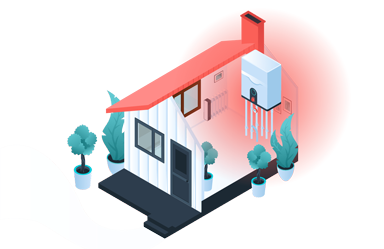Ideal Room Temperature: What Temperature Should I Have at Home?
In any given household, there’s seldom a consensus on what the “ideal” room temperature is — a room heated to 21℃ will feel “about right” to some but chilly or stifling to others.
That’s because our perception of “comfort” varies greatly depending on our physique, level of physical activity, clothes we’re wearing, and simple preference.
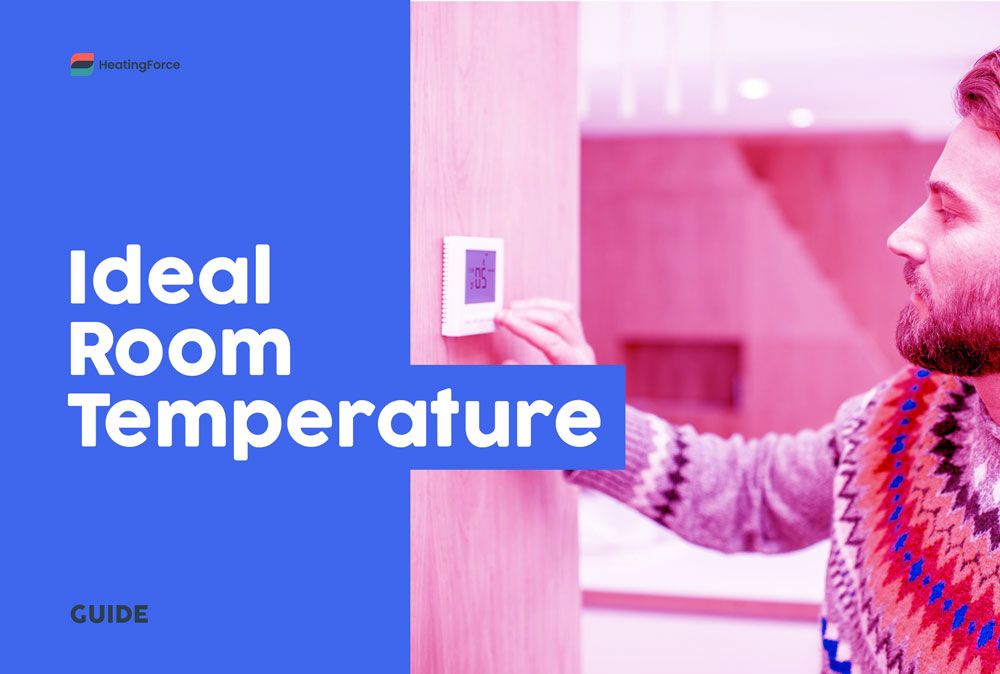
To top it off, a thermometer reading of 21℃ will feel quite different from day-to-day. When it’s humid, this relatively average room temperature may feel sticky and oppressive; on dryer days, you may feel that you want to turn up your central heating up a bit. This disparity stems from the effect air moisture has on how we perceive our ambient temperatures. Higher air humidity makes us feel hotter, and vice versa.
Finding the ideal room temperature is imperative for maintaining your family’s comfort, but also health and well-being.
- Being too warm can cause you to lose focus while being unreasonably cold can leave you vulnerable to respiratory illness and heart attacks.
- Setting your indoor temps too low can also lead to increased mould growth, as spores travel through cool air with greater ease. Mould outbreaks can be damaging both to occupants’ health and property.
Ideal Room Temperature in Different Homes

Our homes are not all made equal. Setting your room temperature to 21℃ in a non-retrofitted Georgian terraced house may cost you £2.00 per day, while the same setting in a modern-era home might set you back only £1.20. In this example, the difference adds up to almost £300 over a year.
That’s because newer homes are built to strict energy standards that demand high-performance insulation and glazing materials. Thanks to these improved envelope materials, newer homes’ walls do a far better job stopping heat transfer than their ancient predecessors ever did. They’re also better at preventing cold air from the outdoors from finding its way into the home.
What’s more, modern architecture takes certain things into account that architects of the past never fathomed. For instance, increasing the percentage of fenestration on a home’s western and southern facades will help owners slash heating costs in winter by allowing passive heating with the sun’s rays.
Keep in mind that modern homes also have their drawbacks. For instance, newer wall assemblies may be so efficient that they actually trap moisture and contribute to mould growth.
What Happens When You Set Your Room Temperature Too High
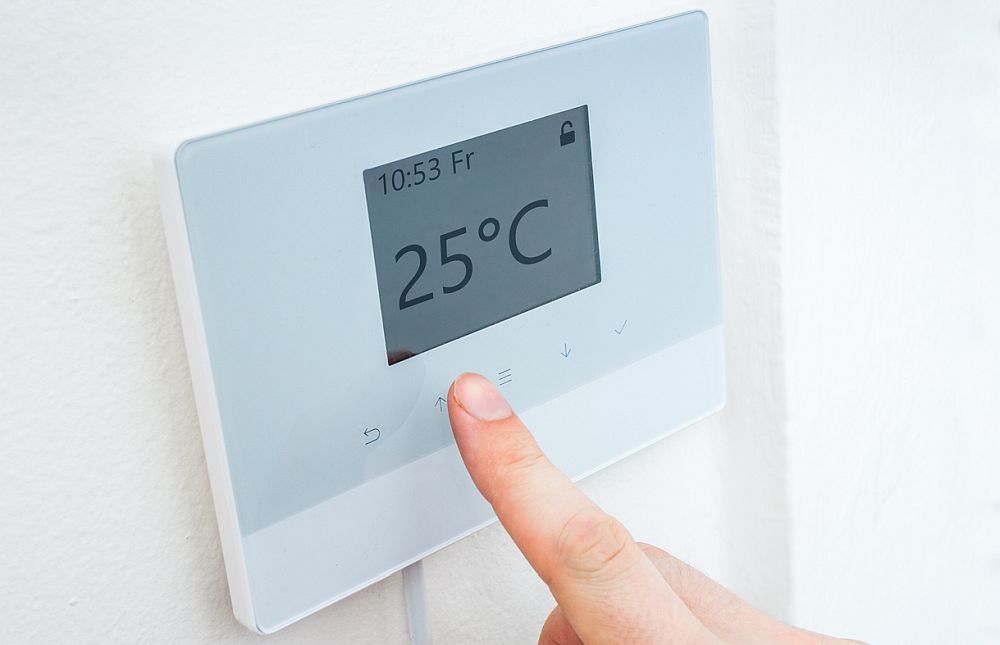
Setting your room temperature above the “ideal” level can harm your well-being, finances, and the environment. As we’ve established above, the definition of “ideal” varies between individuals and is primarily driven by a combination of comfort and economy. That said, most experts agree that the average “ideal” room temperature is around 20-21℃.
So, what happens if you decide to set your thermostat above this “normal” level? And I’m not talking about a quick boost to help you weather a particularly chilly, wintry morning; I mean, what are the implications of consistently inputting a heat setting of more than 21℃ into your thermostat?
Health Impact of Setting the Room Temperature Too High
If you have an infant in your home, raising the room temperature too much increases their risk of Sudden Infant Death Syndrome (SIDS). That’s because babies’ bodies can’t yet self-regulate heat.
As an adult, you’ll also find yourself losing concentration.
A recent study from Harvard University tracked the performance of 2 groups of students — one group lived in air-conditioned quarters, the other had to put up with a nasty heatwave. The second, heat-stressed group performed significantly worse on tests during the study period, scoring lower across a range of test criteria, including concentration and reaction.
Another study — this one from the Lawrence Berkeley National Lab — found that workers’ productivity plummeted as office temperatures soared above 22-23℃.
Then there are other, more sombre analyses showing the effect of heat stress on our mental health. Researchers from Stanford found that every 1℃ increase in monthly temperatures coincided with higher rates of suicide in the US and Mexico.
As global warming picks up pace, I’m afraid that frightening revelations like this are bound to keep piling up.
Financial Impact of Setting the Room Temperature Too High
Now, let’s get back to your living room thermostat. What other dreary things can happen if you set your room temperature too high?
I’ll juxtapose the answer:
Remarkable things can happen if you don’t set your temperatures too high, or even turn the heat down. For every 1℃ you turn that thermostat dial down, Veissmann estimates that you can save up to 6% on your energy bills (depending on the age and condition of your home and heating system). If you don’t trust a boiler vendor with this type of info, here’s another source. The Energy Saving Trust estimates that by lowering the thermostat setting by 1℃, a 3-bedroom home can save £75 annually. If you’re used to a balmy but non-efficient setting of 24℃, turning the dial down to 18℃ could produce savings of up to £450 per year. Not too shabby.
Environmental Impact of Setting the Temperatures Too High
Then, there are the environmental implications. I can’t say with certainty how much more gas your boiler will burn through if you crank your thermostat up too high. This will depend on the state of your home and heating equipment. That said, if you’ve got a modern 24kW boiler that has to stay on an extra hour to hit your above-normal temperature setting, you’ll release approximately 6kg of CO2 into our atmosphere. This stuff adds up fast — keep the high setting for the entire heating season, and you’ve contributed 600kg of CO2. That’s the equivalent of a 6.5-hour flight in a Boeing 747-400.
What Happens When Your Room Isn’t Warm Enough
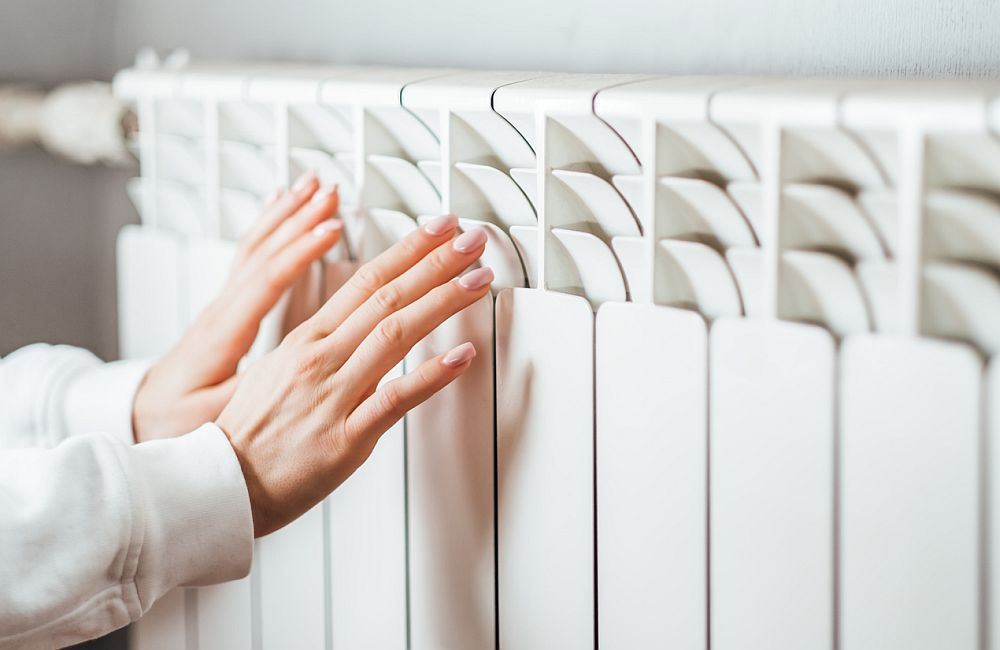
Now that you know the risks of setting your room heat too high, know this: bad things will also befall you if you set it way too low. You just can’t win with this stuff.
Now, with a low thermostat setting, you don’t have to worry about losing focus or feeling depressed. You may even feel a bit ecstatic about averting harmful CO2 from our atmosphere.
But alas, a room that’s cooler than 18℃ has its share of dangers, too. If you’re elderly or have a pre-existing medical condition, low temperatures can trigger all sorts of respiratory and cardiovascular issues, including heart attacks.
Cooler air will also transport mould spores around your home and contribute to fungal outbreaks. Unchecked mould growth can lead to respiratory ailments and cause substantial damage to your home.
What Room Temperature to Have in Your Living Room, Bathroom, and Bedroom
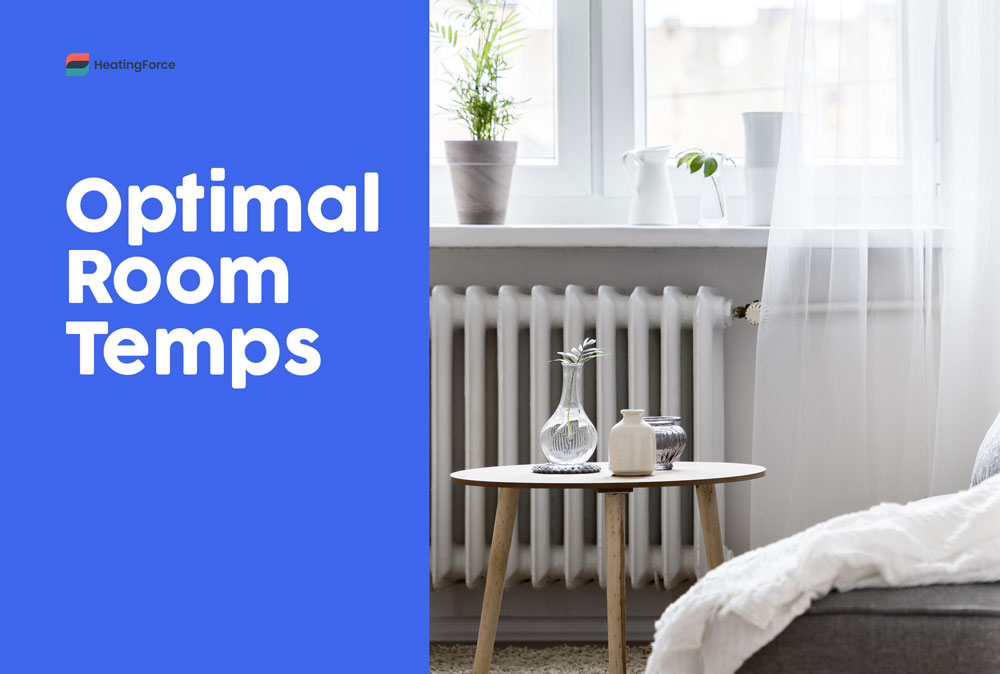
As we saw above, hitting the correct temperature is essential if you want to avoid a host of mental and physical health issues, overpaying for energy, and killing our planet.
But is the same room temperature “ideal” in every room of the house?
Not quite. Bathrooms should be the warmest, bedrooms the coolest while living and working spaces should be somewhere in the middle. Of course, these recommendations will vary depending on specific circumstances. For instance, if the room is used by children, the elderly, or pets, the ideal temperatures may differ.
Keep in mind, too, that having more control over each room’s heating may be a challenge unless your home’s plumbing is designed for zoned heating. If it’s not, the most economical way of achieving zoned control is by investing in Thermostatic Radiator Valves (TRV) for your radiator and a thermostat that allows multi-zone heating.
Ideal Room Temperature for Your Living Room
To feel comfortable in your living room, heat it to an average temperature of about 20-22℃. This is the place where you spend most of your time, either in regular clothes or pyjamas, so you’ll want that “happy middle” setting that’s not too hot to affect your concentration but not too cold for comfort. These temperatures also work for your home office.
Ideal Room Temperature For Your Bathroom
This is perhaps the only room of your house where you’re fully justified in cranking up the heat. After all, you don’t want a frigid wall of air to greet you as you jump out of a hot shower. The good news is that all the humidity your ablutions generate will help the air retain heat, so your poor old boiler won’t have to work as hard and burn all that extra gas. Go ahead and set it at 22-24℃.
Optimal Bedroom Temperature
If you value a good night’s sleep, your bedroom should have the coolest room temperature of all the living spaces in your home.
If you’ve ever lived through a heatwave, I’m sure you know that heat and sleep just do not go well together. Sticky, sweaty sheets; moist, stifling air; frustration, anger, panic; then, finally relief as the morning cool takes over — just in time for the alarm clock to go off.
It’s a fact — cool ambient temperatures aid sleep and can even offer a reprieve from episodes of insomnia. Scientists attribute this to the fact that our body temperature drops when we’re asleep, and when the ambient temperature disrupts the body’s natural cycle, sleep naturally gets disturbed. What’s more, a decrease in body temps contributes to the production of melatonin, a crucial hormone that enables sleep.
So, what’s the right temperature for a bedroom? Scientists believe that 15-19℃ is the ideal range, and don’t recommend setting your thermostat above 20℃. Depending on your children’s age, their bedrooms should be a bit warmer, with the best room temperature ranging between 16℃ and 20℃.
Recommended Room Temperature for Kitchens
Let’s address kitchens first since they’re a bit tricky. Most people don’t spend as much time cooking as they do in the living room or bedroom; that said, you still want to feel comfortable when you’re preparing a meal. So, technically, we can default to our average room temperature here and go with 20℃.
But what if you’re using your oven or multiple burners on the range? If you’ve got an average, modern stove, and you have all your burners on along with the oven, you’re producing about 12kWh — or half a standard boiler’s output. That’s a whopping amount of heat that can quickly overwhelm your kitchen. It begs the question — is there any point in heating your kitchen to a specific level if you’re planning to cook a large family dinner and intend on using several burners simultaneously? In this scenario, it’s best to keep it down to 18℃.
On the other hand, if you’re making your morning’s first cup of Earl Grey after hopping out of the shower, then, of course, you’d best give your kitchen a boost of warmth.
Optimal Room Temperature for Corridors, Entryways, and Storage Rooms
With comfort and well-being out of the equation, you can keep these rooms as cool as 15-18℃ during the heating season. Conversely, you don’t need to air-condition them during summer heatwaves.
To Summarise — Ideal Room Temperatures at a Glance
For your convenience, here’s a quick table with the ideal room temps across a range of different spaces:
| Room | Temperature |
| Living room | 20-22℃ |
| Office/study | 20-22℃ |
| Kitchen | 18-20℃ |
| Bathroom | 22-24℃ |
| Bedroom | 15-19℃ |
| Children’s bedroom | 16-20℃ |
| Corridors, entryways, storage rooms | 15-18℃ during the heating season |
Ideal Room Temperature FAQs
What is the best room temperature for infants and children?
It’s a delicate balance, but the key is not to overheat the room, especially if you have a newborn. Extensive studies have linked excessive heat to Sudden Infant Death Syndrome (SIDS). With this in mind, it’s better to go against your natural instinct (which, for some of us, is to keep the baby as warm as possible) and set the nursery room temperature a bit lower; the NHS recommends a range between 16℃ and 20℃.
For toddlers, who are no longer at risk of SIDS, slightly higher temperatures of 17℃ to 21℃ may be a more comfortable temperature.
Note — since all babies and children have their unique needs, it’s best to get your midwife’s or paediatrician’s input when determining the ideal nursery temperature.
What is the optimal room temperature during pregnancy?
The vast majority of women feel hotter while pregnant, a phenomenon caused by increased blood volume. For your health and that of your baby, it’s vital to stay cool and prevent overheating at all costs. The ideal room temperature range of 20℃ -22℃ should work well, but the thermal comfort level differs for everyone, so you may feel that it’s too warm or too cool. Try experimenting with your thermostat, but still err on the cooler side to avoid heat stress.
Note — since your and your baby’s health are at stake, please consult with a qualified medical professional (preferably an obstetrician or midwife) to establish the ideal temperature setting.
What is the ideal room temperature for the elderly?
According to the NHS, people 65 and older shouldn’t set their thermostats below 18℃ to avoid health complications. This minimum temperature is of particular importance in bedrooms, as body temperature usually drops during sleep.
What is the best room temperature for pets?
Much like us, most pets prefer a room temperature of 20°C to 22℃. Of course, this may differ depending on the breed, age, health, weight, and coat type. That said, you can play it safe by never letting your temps rise above 25℃ in the summer or dip below 16℃ in the winter. If your pet has a health condition, be sure to check with your veterinarian first.
What is a typical thermostat setting?
According to our survey, which was based on 1,256 UK households, 70% of households set their thermostats between 18℃ and 20℃. This current average would be considered balmy back in the 1970s when most thermostats were set to 12-13℃.
Can I control my heating better with smart thermostats?
It depends on the consistency of your schedule. By definition, “smart” thermostats learn their users’ heating patterns and use this data to set up efficient heating programmes. If your household adheres to a steady daily routine, a smart thermostat has a better chance to set up a heating schedule that strikes a balance between comfort and efficiency.
On the other hand, if your daily timetable isn’t predictable, any programme your smart thermostat comes up with may be out of tune with your needs. This means that you may find yourself overriding it manually.
Don’t forget that the state of your heating equipment is equally vital to maintaining your desired room temperature without consuming too much energy. If your boiler is outdated, chances are it has to work harder and burn more fuel to warm up a cold room and keep your room temperature at the correct level. You can check out our boiler replacement guide and learn more about your options, or fill out this 90-second survey from Heatable and see their selection of boilers.
Final Thoughts
The optimal room temperature differs for everyone and hinges on a range of factors. That said, there’s a relatively narrow window of temperature settings that strike a balance between health, comfort, and costs. By keeping your room temperature between 18℃ and 22℃, you can avoid hefty energy bills and ward off various ailments.
Need some help maintaining the ideal room temperature in your home? Have a look at our guides for the best smart thermostats in 2026!
